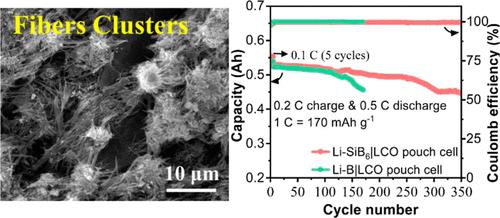当前位置:
X-MOL 学术
›
Inorg. Chem.
›
论文详情
Our official English website, www.x-mol.net, welcomes your
feedback! (Note: you will need to create a separate account there.)
Stabilizing Lithium Metal Anodes by Fiber Clustering
Inorganic Chemistry ( IF 4.3 ) Pub Date : 2024-11-19 , DOI: 10.1021/acs.inorgchem.4c03719 Caihong Wu, Piao Qing, Haifeng Huang, Wen Pan, Shaozhen Huang, Libao Chen, Lin Mei, Zhibin Wu
Inorganic Chemistry ( IF 4.3 ) Pub Date : 2024-11-19 , DOI: 10.1021/acs.inorgchem.4c03719 Caihong Wu, Piao Qing, Haifeng Huang, Wen Pan, Shaozhen Huang, Libao Chen, Lin Mei, Zhibin Wu

|
Lithium metal anodes generally suffer from uncontrolled dendrite growth and large volume change, while traditional skeletons such as Li13In3 and Li22Sn5 are too heavy and discontinuous to offer highly efficient structural supportability for composite Li anodes. In this work, lightweight and stable fiber-clustered skeletons, which are composed of LiB fibers and jointed Li22Si5 nanoparticles, can be obtained by smelting SiB6 powder and Li ingots. In addition to serving as both ionic and electronic conductors for composite Li anodes, the stable skeletons reduced volumetric fluctuation by offering uniform, heterogeneous, and continuous architectures while suppressing lithium dendrites with low nucleation overpotential and diffusion energy barrier. As a result, the Li–SiB6|Li–SiB6 symmetrical cells achieve an ultralong lifespan over 2000 h cycling at 1 mA cm–2 and 1 mA h cm–2. Eventually, the Li–SiB6|LiFePO4 full cells exhibit a long-term cyclability of 400 cycles with a high-capacity retention of 94.5% at 2 C, and the Li–SiB6|LiCoO2 pouch cells exhibit an impressive 85% capacity retention after 350 cycles. This work develops a new strategy to strengthen the stability of fibrous skeletons and minimize volume changes for dendrite-free Li metal anodes.
中文翻译:

通过纤维聚集稳定锂金属负极
锂金属负极通常遭受不受控制的枝晶生长和较大的体积变化,而 Li13In3 和 Li22Sn5 等传统骨架太重且不连续,无法为复合 Li 负极提供高效的结构支撑能力。本工作通过冶炼 SiB6 粉末和锂锭可获得由 LiB 纤维和关节结合的 Li22Si5 纳米颗粒组成的轻质稳定的纤维团簇骨架。除了用作复合锂负极的离子和电子导体外,稳定的骨架还通过提供均匀、异质和连续的结构来减少体积波动,同时抑制具有低成核过电位和扩散能垒的锂枝晶。因此,Li–SiB6|Li-SiB6 对称电池在 1 mA cm–2 和 1 mA h cm–2 下循环 2000 小时后实现了超长寿命。最终,Li–SiB6|LiFePO4 全电池在 2 C 下表现出 400 次循环的长期可循环性和 94.5% 的高容量保持率,而 Li-SiB6|LiCoO2 软包电池在 350 次循环后表现出令人印象深刻的 85% 容量保留率。这项工作开发了一种新的策略来加强纤维骨架的稳定性并最大限度地减少无树晶锂金属负极的体积变化。
更新日期:2024-11-20
中文翻译:

通过纤维聚集稳定锂金属负极
锂金属负极通常遭受不受控制的枝晶生长和较大的体积变化,而 Li13In3 和 Li22Sn5 等传统骨架太重且不连续,无法为复合 Li 负极提供高效的结构支撑能力。本工作通过冶炼 SiB6 粉末和锂锭可获得由 LiB 纤维和关节结合的 Li22Si5 纳米颗粒组成的轻质稳定的纤维团簇骨架。除了用作复合锂负极的离子和电子导体外,稳定的骨架还通过提供均匀、异质和连续的结构来减少体积波动,同时抑制具有低成核过电位和扩散能垒的锂枝晶。因此,Li–SiB6|Li-SiB6 对称电池在 1 mA cm–2 和 1 mA h cm–2 下循环 2000 小时后实现了超长寿命。最终,Li–SiB6|LiFePO4 全电池在 2 C 下表现出 400 次循环的长期可循环性和 94.5% 的高容量保持率,而 Li-SiB6|LiCoO2 软包电池在 350 次循环后表现出令人印象深刻的 85% 容量保留率。这项工作开发了一种新的策略来加强纤维骨架的稳定性并最大限度地减少无树晶锂金属负极的体积变化。


















































 京公网安备 11010802027423号
京公网安备 11010802027423号